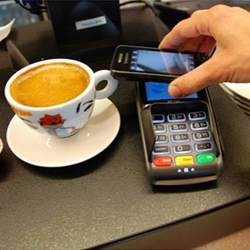
For anyone that has stopped in to a Starbucks for a quick caffeine fix, the coffee retailer’s mobile app is a fixture at the checkout counter. Customers using Starbucks’ mobile app on their smartphone are able to scan a barcode and complete their transaction without swiping a card or exchanging cash. Starbucks reported that mobile payments represented a quarter of all payments in its U.S. stores in fiscal year 2015. This is a major milestone, and has been the motivation for other major merchants to emulate this payment model.
Starbucks’ mobile payment capabilities are part of a growing trend among retailers to offer closed loop digital payments. As the name implies, closed loop means that the payment can only be used within a specific retailer’s stores. In recent months, Walmart has rolled out Walmart Pay across its more than 4,600 stores in the U.S. Apparel retailer Kohl’s recently launched the Kohl’s Pay proprietary digital payment app. Other major merchants with private label digital wallets include Taco Bell, CVS, and Dunkin Donuts.
The closed loop digital payments trend is interesting considering the proliferation of open digital wallets—namely, Apple Pay, Android Pay, and Samsung Pay—which enable customers to shop with their mobile device in millions of retail stores. The cost of creating proprietary mobile payment functionality can be considerable, with the talent of application developers being at a premium.
Large companies are spending millions of dollars on developing apps, so why are retailers investing so heavily on closed loop digital wallets? According to Eric Grover, principal at Intrepid Ventures, a corporate development and strategy consultancy advising payment issuers, networks, processors, and other payments companies, the answer is pretty simple: loyalty. “Big merchants are promoting proprietary in-app digital wallets to enhance existing programs and boost customer engagement,” says Grover. Increased customer engagement can translate into more frequent customer visits and more loyal customers. Most large retailers have loyalty programs and cobranded credit card programs in place, and adding a digital wallet allows merchants to extend their existing programs to a digital channel.
In addition, retailers have an opportunity to take greater control of payments. Steve Mott, principal of BetterBuyDesign, said retail merchants generally do not want to be in the payments business, but the market “forces those that have the belief that they can still control their fates to work harder to control their payments.”
According to Mott, “General-purpose digital/mobile wallets, such as Apple Pay, merely enable the biggest credit card issuers to promote their top-of-wallet cards in these new digital venues.” Merchants that build digital wallet functionality into their mobile apps, on the other hand, have greater control over payments, which can result in cost savings. Directing consumers to the lowest-cost payment option can save retailers on every transaction, resulting in potentially millions in savings over the course of a year.
The computing challenges of creating a closed loop digital wallet can be daunting, as the underlying systems can be difficult to manage. The payments ecosystem, for example, is quite complex and involves many moving parts from multiple industry players. According to Mott, “Visa and Mastercard operate a duopoly that exerts substantial market power through carefully contrived rules that suppress competition and enable little or no ability to negotiate fees or express preferences for better security.”
Fortunately, Visa and Mastercard have created open platforms for developers. Using APIs and software development kits, application developers can leverage data previously available only to the payment networks. This puts more power in the hands of retailers that want to have greater control of where and how payments are processed.
Walmart Pay was announced in December 2015, but the world’s largest retailer took its time and phased in the functionality across last summer to all of its stores. While Apple Pay and Android Pay rely on the near-field communications (NFC) chips built into smartphones, Walmart Pay has gone the route of using QR codes to enable payments. The technology behind Walmart Pay takes advantage of the smartphone’s camera feature to capture a QR code that initiates the payment, while the fingerprint reader available on most modern smartphones can be used to authorize payments. Walmart Pay was integrated into the retailer’s existing mobile app, which had a number of loyalty features already built in.
Walmart reports early adoption of the digital wallet has been going well. The company was somewhat surprised that Gen X and Baby Boomer women make up the largest segment of users, rather than the expected tech-savvy millennial males.
Kohl’s Pay is focused on the retailer’s desire to build loyalty. Kohl’s Pay enables Kohl’s private-label credit card holders to check out at the point of sale using their card. This is an example of a retailer providing a customer a convenience of mobile checkout, while at the same time retaining control over the method of payment. The result is greater use of Kohl’s private-label card, which is a lower-cost payment method for the retailer.
One of the challenges retailer-specific digital wallets could face is a saturation of apps in the market. According to the 2015 Colloquy Census, the average household holds memberships to 29 loyalty programs. Americans’ wallets are stuffed with loyalty and rewards cards, and keeping track of which ones we have can be difficult.
Starbucks has made its app an essential part of checkout; other retailers need to follow suit with well-designed applications that remove friction rather than turning mobile phones into a virtual pile of unused loyalty cards.
Mark Broderick is a Tampa, FL-based writer and analyst covering the financial services and payments industries.



Join the Discussion (0)
Become a Member or Sign In to Post a Comment